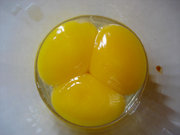» View the recipes involving egg
 Bird eggs are a common food source. The most commonly used bird eggs are those from the chicken, duck, and goose, but smaller eggs such as quail eggs are occasionally used as a gourmet ingredient, as are the largest bird eggs, from ostriches. The eggs of turtles are sometimes used for food also. Eggs are frequently used in both sweet and savoury dishes as a source of protein and/or to bind the other ingredients in a recipe together. Sometimes the whole egg is cooked together. Sometimes the egg yolk is used separately from the egg white (or albumen). Bird eggs are a common food source. The most commonly used bird eggs are those from the chicken, duck, and goose, but smaller eggs such as quail eggs are occasionally used as a gourmet ingredient, as are the largest bird eggs, from ostriches. The eggs of turtles are sometimes used for food also. Eggs are frequently used in both sweet and savoury dishes as a source of protein and/or to bind the other ingredients in a recipe together. Sometimes the whole egg is cooked together. Sometimes the egg yolk is used separately from the egg white (or albumen).
 The egg yolk is suspended in the egg white by one or two spiral bands of tissue called the chalaza (Greek word from "khalaza" meaning hailstone, or hard lump.) The egg yolk is suspended in the egg white by one or two spiral bands of tissue called the chalaza (Greek word from "khalaza" meaning hailstone, or hard lump.)
Chicken eggs are the most commonly eaten egg. They represent an excellent nutritional value. Eggs are high in complete protein and provide significant amounts of several vitamins and minerals (Vitamin A, Riboflavin, Folic Acid, Vitamin B6 and Vitamin B12, and Iron). Eggs are often the cheapest source of complete animal protein available which is essential to health and well being. All of the egg's vitamin A, D and E are in the yolk, they are one of the few foods naturally containing vitamin D. A large egg yolk contains approximately 60 calories, the egg white contains about 15 calories. A large yolk contains more than two-thirds of the recommended daily limit of 300mg of cholesterol. The yolk makes up about 33% of the liquid weight of the egg. It contains all of the fat in the egg and almost half of the protein. Recently chicken eggs that are especially high in Omega 3 fatty acids have come on the market. These eggs are made by feeding laying hens a diet containing polyunsaturated fats and kelp meal. Eggs, particularly their yolks, are important as binding agents in many preparations in European cooking due to the emulsifying action of lecithin. This property is crucial for sauces such as mayonnaise and Hollandaise, custards such as crème anglaise, crème brûlée, flan and lemon custard, and meat dishes such as sausages and pâté. Eggs may also be pickled, hard-boiled and refrigerated, or eaten raw, though the latter is not recommended for people who may be susceptible to salmonella, such as the old, the infirm, or pregnant women. If an egg is overcooked a greenish ring sometimes appears around egg yolk, this is the result of iron and sulfur compounds in the egg. it can also occur when there is much iron in the cooking water. The green ring affects neither taste nor nutrition. When eggs become rotten, the yolk will turn green and the egg will emit a sulfurous smell when broken. Although deemed offensive by most Western palates, fermented eggs are considered a delicacy by some in China, when prepared using a special method which includes letting them sit for three months to age (or rot, depending on one's interpretation).
Season specials: Easter Recipes, Passover Recipes, Christmas Recipes, Season Recipes, Xmas Recipes
|